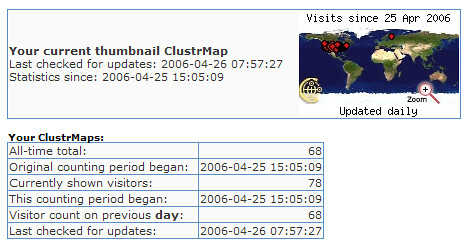Advice on Hurricanes
Please read the following info, as it may pertain to you!!
ADVICE ON HURRICANES
We're about to enter the peak of the hurricane season. Any day now,
you're going to turn on the TV and see a weather person pointing to
some radar blob out in the Gulf of Mexico and making two basic
meteorological points:
(1) There is no need to panic.
(2) We could all be killed.
Yes, hurricane season is an exciting time to be in Florida. If you're
new to the area, you're probably wondering what you need to do to
prepare for the possibility that we'll get hit by "the big one." Based
on our experiences, we recommend that you follow this simple
three-step hurricane preparedness plan:
STEP 1. Buy enough food and bottled water to last your family for at
least three days. STEP 2. Put these supplies into your car. STEP 3.
Drive to Ohio and remain there until Halloween. Unfortunately,
statistics show that most people will not follow this sensible plan.
Most people will foolishly stay here in Florida.
We'll start with one of the most important hurricane preparedness
items:
HURRICANE INSURANCE: If you own a home, you must have hurricane
insurance.
Fortunately, this insurance is cheap and easy to get, as long as your
home meets two basic requirements: (1) It is reasonably well-built,
and (2) It is located in Ohio.
Unfortunately, if your home is located in Florida, or any other area
that might actually be hit by a hurricane, most insurance companies
would prefer not to sell you hurricane insurance, because then they
might be required to pay YOU money, and that is certainly not why they
got into the insurance business in the first place. So you'll have to
scrounge around for an insurance company, which will charge you an
annual premium roughly equal to the replacement value of your house.
At any moment, this company can drop you like used dental floss. Since
Hurricane George, I have had an estimated 27 different home-insurance
companies. This week, I'm covered by the Bob and Big Stan Insurance
Company, under a policy which states that, in addition to my premium,
Bob and Big Stan are entitled, on demand, to my kidneys.
SHUTTERS: Your house should have hurricane shutters on all the
windows, all the doors, and -- if it's a major hurricane -- all the
toilets. There are several types of shutters, with advantages and
disadvantages:
Plywood Shutters: The advantage is that, because you make them
yourself, they're cheap. The disadvantage is that, because you make
them yourself, they will fall off.
Sheet-Metal Shutters: The advantage is that these work well, once you get them all up. The disadvantage is that once you get them all up,
your hands will be useless bleeding stumps, and it will be December.
Roll-Down Shutters: The advantages are that they're very easy to use,
and will definitely protect your house. The disadvantage is that you
will have to sell your house to pay for them.
Hurricane-Proof Windows: These are the newest wrinkle in hurricane
protection. They look like ordinary windows, but they can withstand
hurricane winds! You can be sure of this, because the salesman says
so. He lives in Ohio.
HURRICANE PROOFING YOUR PROPERTY: As the hurricane approaches, check
your yard for movable objects like barbecue grills, planters, patio
furniture, visiting relatives, etc. You should, as a precaution, throw
these items into your swimming pool (if you don't have a swimming
pool, you should have one built immediately). Otherwise, the hurricane
winds will turn these objects into deadly missiles.
EVACUATION ROUTE! : If you live in a low-lying area, you should have
an evacuation route planned out. (To determine whether you live in a
low-lying area, look at your driver's license; if it says "Florida,"
you live in a low-lying area).
The purpose of having an evacuation route is to avoid being trapped in
your home when a major storm hits. Instead, you will be trapped in a
gigantic traffic jam several miles from your home, along with two
hundred thousand other evacuees. So, as a bonus, you will not be
lonely.
HURRICANE SUPPLIES: If you don't evacuate, you will need a mess of
supplies. Do not buy them now! Florida tradition requires that you
wait until the last possible minute, then go to the supermarket and
get into vicious fights with strangers over who gets the last can of
SPAM.
In addition to food and water, you will need the following supplies:
23 flashlights and at least $167 worth of batteries that won't work or
will be the wrong size for the flashlights.
Bleach. (No, I don't know what the bleach is for. NOBODY knows what
the bleach is for, but it's traditional, so GET some!)
A 55-gallon drum of underarm deodorant.
A big knife that you can strap to your leg. (This will be useless in a
hurricane, but it looks cool.)
A large quantity of raw chicken to placate the alligators. (Ask
anybody who went through a hurricane; after the hurricane, there WILL
be irate alligators.)
$35,000 in cash or diamonds so that, after the hurricane passes, you
can buy a generator from a man with no discernible teeth.
Of course these are just basic precautions. As the hurricane draws
near, it is vitally important that you keep abreast of the situation
by turning on your television and watching TV reporters in rain
slickers stand right next to the ocean and tell you over and over how
vitally important it is for everybody to stay away from the ocean.
Good luck, and remember: It's great living in Paradise.
Thanks Laura!
Labels: generator, statistics, windows







